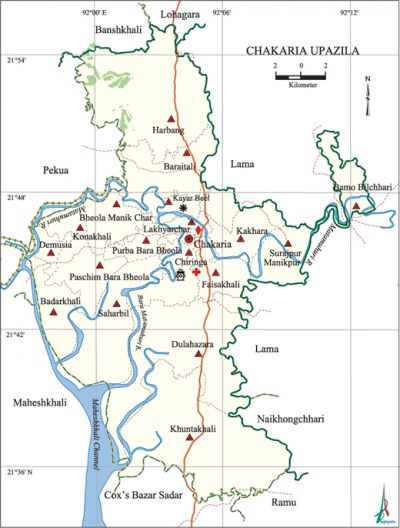Chakaria Upazila
Chakaria Upazila (cox’s bazar district) area 970.32 sq km, located in between 21°34' and 21°55' north latitudes and in between 91°54' and 92°54' east longitudes. It is bounded by lohagara and banshkhali upazilas on the north, cox’s Bazar Sadar and ramu upazilas on the south, Lama and naikhongchhari upazilas on the east, maheshkhali and pekua upazilas on the west.
Population Total 319142; male 164775, female 154367; Muslim 474977, Hindu 22375, Buddhist 1299, Christian 4133 and others 606. Indigenous communities such as Mag, marma, Murong and chakma belong to this upazila.
Water bodies The upazila is surrounded by matamuhuri, Bara Matamuhuri, Maheshkhali and Kutubdia Channel.
Administration Chakaria Thana was formed in 1793 and it was turned into an upazila in April 1983
| Upazila | ||||||||
| Municipality | Union | Mouza | Village | Population | Density (per sq km) | Literacy rate (%) | ||
| Urban | Rural | Urban | Rural | |||||
|
1 |
18 |
55 |
221 |
50993 |
452397 |
329 |
39.96 |
31.11 |
| Municipality | ||||||||
|
Area |
Ward |
Mahalla |
Population |
Density |
Literacy rate (%) | |||
|
15.77 |
9 |
23 |
50993 |
3234 |
39.96 | |||
| Union | ||||
| Name of union and GO code | Area (acre) | Population | Literacy rate (%) | |
| Male | Female | |||
|
Kayar Beel 61 |
1970 |
8394 |
8166 |
30.92 |
|
Kakhara 55 |
14087 |
14538 |
13497 |
34.11 |
|
Konakhali 22 |
2495 |
3934 |
3912 |
28.44 |
|
Khuntakhali 67 |
19249 |
14065 |
12361 |
35.07 |
|
Chiringa 27 |
5355 |
6612 |
5936 |
23.35 |
|
Dulahazara 33 |
16499 |
17004 |
15657 |
34.76 |
|
Demusia 94 |
1993 |
5200 |
4894 |
22.20 |
|
Paschim Bara Bheola 94 |
6415 |
9302 |
8567 |
29.72 |
|
Purba Bara Bheola 39 |
11176 |
11373 |
10889 |
33.94 |
|
Faisakhali 44 |
4400 |
9682 |
9263 |
36.53 |
|
Baraitali 16 |
65000 |
13185 |
13005 |
32.26 |
|
Badarkhali 10 |
4375 |
13113 |
12263 |
32.55 |
|
Bamo Bilchhari 12 |
2937 |
5722 |
4464 |
35.27 |
|
Bheola Manik Char 22 |
63200 |
15473 |
15110 |
32.00 |
|
Lakhyarchar 72 |
1478 |
6451 |
6007 |
40.81 |
|
Surajpur Manikpur 55 |
2284 |
2561 |
2373 |
19.45 |
|
Saharbil 80 |
2577 |
8278 |
7565 |
38.76 |
|
Harbang 50 |
17092 |
11583 |
11617 |
32.09 |
Source Bangladesh Population Census 2001, Bangladesh Bureau of Statistics.

Archaeological heritage and relics Tomb of Shah Umar, Sat-gumbad Masjid of Fazl Quke at Manikpur (1873).
History of the War of Liberation During the war of liberation in 1971 the Pak army shot 13 villagers dead and burnt more than one hundred houses and shops in different places of the upazila.
Marks of the War of Liberation Memorial monument 1 (Shaheed Abdul Hamid).
Religious institutions Mosque 455, temple 52, church 3, pagoda 16.
Literacy rate and educational institutions Average literacy 33.48%; Male 39.18%, Female 30.54%. Educational institutions: college 4, secondary school 34, primary school 153, satellite school 19, madrasa 983. Noted educational institutions: Chakaria Govt. High School (1919), Chakaria Multilateral Adarsha High School, Manikpur Burmese Govt. Primary School (1828), Harbang Govt. Primary School (1884), Pekua Government Primary School (1918), Saharbil Anwarul Ulum Senior Madrasa (1918).
Newspapers and periodicals Weekly: Chakori, fortnightly: Mehdi.
Cultural organisations Club 52, literary organisation 3, women's organisation 22, theatre group 2, playground 50.
Tourist spots Dulahazara Safari Park, Chakaria Sundarban, Dulahazara Deer Breeding Centre, Dighi of Bir Kamala.
Main sources of income Agriculture 53.09%, non-agricultural labourer 7.80%, industry 0.75%, commerce 15.01%, transport and communication 2.94%, service 6.7%, construction 1.1%, religious service 0.24%, rent and remittance 1.13% and others 11.24%.
Ownership of agricultural land Landowner 34.30%, landless 65.70%; agricultural landowner: urban' 25.95% and rural 35.19%.
Main crops Paddy, potato, mustard, sweet potato, chili, corn, sugarcane, wheat, peanut, betel leaf, tobacco, cauliflower, tomato, cabbage, brinjal, lady's finger, barbati, felon.
Extinct or nearly extinct crops Lentil, gram, kaun, linseed.'
Main fruits Mango, jackfruit, litchi, banana, papaya, pine-apple, guava, lemon, watermelon.
Fisheries, dairies and poultries This upazila has a number of fisheries, dairies and poultries.
Communication facilities Pucca road 52 km, semi-pucca road 190 km, mud road 560 km.
Extinct or nearly extinct traditional transport Horse carriage, bullock cart,.
Noted manufactories Flour mill, rice mill, saw mill, ice factory, salt factory, printing press, welding factory.
Cottage industries Goldsmith, blacksmith, potteries, weaving, fish preservation centre, bamboo work, wood work.
Hats, bazars and fairs Hats and bazars are 39, fairs 1, Rajakhali Alek Shah Bazar, Pekua Hat, Badarkhali Hat, Khuta-khali Hat, Magh Bazar and Chakariar Ghor-daur Mela are notable.
Main exports Shrimp, salt, tobacco, peanut, mustard, flour, watermelon, wood.
Access to electricity All the wards and unions of the upazila are under rural electrification net-work. However 12.37% of the dwelling households have access to electricity.
Sources of drinking water Tube-well 94.32%, tap 0.51%, pond 1.07% and others 4.10%.
Sanitation 31.70% (urban 66.94% and rural 27.95%) of dwelling households of the upazila use sanitary latrines and 11.41% (urban 7.65% and rural 11.82%) of dwelling households use non-sanitary latrines; 56.82% of households do not have latrine facilities.
Heath centres Upazila health centre 1, satellite clinic 6, family planning centre 7, hospital 2.
Natural disasters The devastating cyclone and the tidal bore of 29 April 1971 caused serious damages to the upazila with a death of 16705 persons.
NGO activities Operationally important NGOs are brac, CARE, caritas, proshika, asa, The Hunger Project. [Zakerullah Chakori]
References Bangladesh Population Census 2001, Bangladesh Bureau of Statistics; Cultural survey report of Chakaria Upazila 2007.
